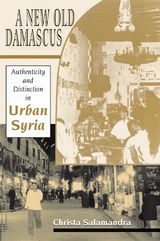
by Christa Salamandra
Lehman College, CUNY
If you enter the Old City of Damascus at Bab Sharqi (the Eastern Gate), walk a few yards along a Street Called Straight, and turn down the first narrow alley on your right, you will find, jutting out from among the inward-looking Arab-style houses of this quiet residential quarter, a sign advertising “Le Piano Bar.†Enter through the carved wooden door, walk along the tile-covered foyer, under the songbird’s cage, past a display case strung with chunky silver necklaces, and step up a stone platform to the raised dining room. Here well-heeled Syrians sit at closely spaced tables, drinking arak and Black Label whiskey, and eating grilled chicken or spaghetti. The walls around are decorated, each in a different style. One features a collection of Dutch porcelain plates set into plaster. In another, strips of colored marble hold a series of mosaic-lined, glass-covered displays of wind instruments. A third wall features two floral wrought-iron gated windows draped in a locally produced striped fabric. Wrought-iron musical notes dance on the last. At the from of the long, arch-divided room is a huge mother-of-pearl-framed mirror. Set into the top of the mirror is a digital billboard across which Le Piano Bar’s menu and opening hours float repeatedly. Patrons listen politely as the proprieter sings “My Way†and other Frank Sinatra favorites to a karaoke backing tape. When he finishes, video screens tucked into corners feature Elton John song sing-alongs. Some nights a pianist and clarinetist play Russian songs as patrons clack wooden catanets.
On the surface, Le Piano Bar appears as kitsch, as a complete loss of aesthetic confidence. With its ironic iconography drawing on past and present, near and far, local and global, this establishment provides a point of acccess into the experience of late-twentieth-century modernity in Syria, reflecting its disjunctures and contradictions, fragmentations and paradoxes. It forms part of a complex system in which social distinction is negotiated through an idiom of local public culture. Neither kitsch nor cultural imperialism, Le Piano Bar operates as a system of signs whose decoding reveals a cosmopolitanism that values the local alongside the global. It is among the most colorful of a range of new cultural forms invoking Old Damascus. Restaurants, cafés, television programs, nostalgic memoirs, art exhibits, and social gatherings all attempt to reproduce tradition through the terms of a newer, wider world. They are also highly contentious constructs which often operate as idioms of exclusion, distinguishing an old urban elite from powerful new rivals.
[Excerpt from the Introduction to Christa Salamandra’s A New Old Damascus: Authenticity and Distinction in Urban Syria (Bloomington: Indiana University Press, 2004), pp. 1-2.]